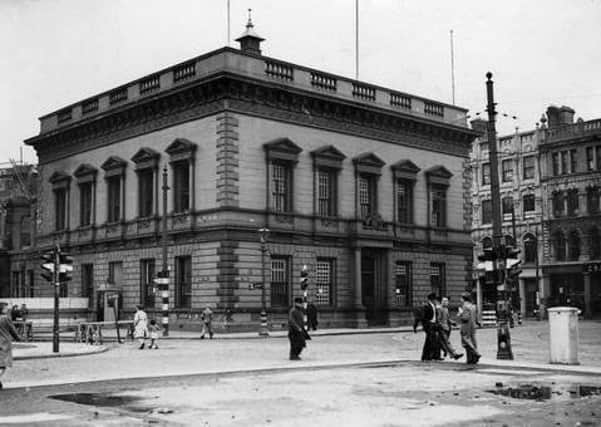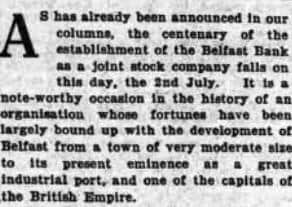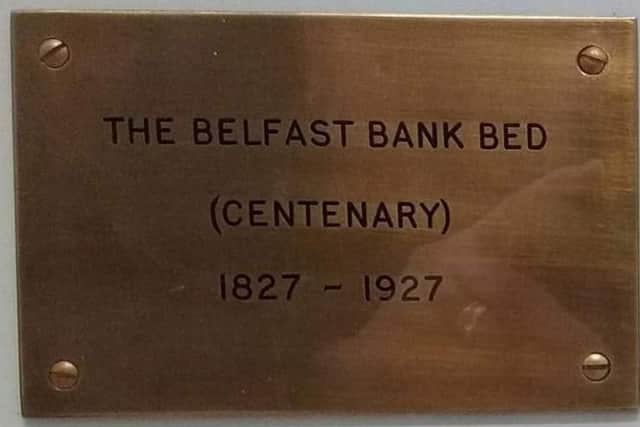Bank merger ‘a note-worthy occasion in the history of an organisation’


The merger was preceded by a long, proud history, some of it shared here on Wednesday by Gavin Bamford, a retired Northern Bank Assistant Manager who worked for the company from 1974 to 2013.
Gavin often contributes to this page as Chair of History Hub Ulster, but he also runs the Northern Bank War Memorials website and the Belfast Banking Company Architecture Facebook page - all very well worth perusing.
Advertisement
Hide AdAdvertisement
Hide AdContinuing from Wednesday’s account, on April 1, 1965 news broke that the Midland Bank (as London City & Midland Bank was then known) was proposing to purchase all the share capital of Northern Bank.


Belfast Bank branch managers were advised in an official circular - “It is not the intention to merge the Northern Bank with the Belfast Banking Company, but as opportunities occur in the future it will be possible to effect some rationalisation to the advantage of all concerned.”
Late 1967 saw the arrival into both banks of a team from Midland Bank with the aim of bringing their systems into line with each other.
On November 20, 1968, staff were informed of the creation of ‘United Northern Banks Limited’ to later complete the integration of the two banks.
Press advertising started the following week.
Advertisement
Hide AdAdvertisement
Hide Ad

On November 29, 1968 newspaper ads appeared promoting the name of ‘United Northern Banks Limited’ as ‘the big new name in Irish banking’.
This holding company, registered in Northern Ireland, was to promote a gradual harmonising of methods and services, thus fostering closer co-operation between the two banks.
At that stage there were 287 offices of both the Belfast Banking Company Limited and Northern Bank Limited.
It would take until late 1969 for their directors to decide on the name of the future organisation.
Advertisement
Hide AdAdvertisement
Hide AdA process of legal changes involving Acts of Parliament on both sides of the border would be required and then there was the (bank) note-issuing rights that dated back to Victorian times.
A separate 3rd company would not be able to retain the note-issuing powers currently held by both banks.
A Private Bill was to be enacted in the Parliament of Northern Ireland that would allow the merger of the two banks on July 1, 1970 without the use of the third company.
The Belfast Bank Executor & Trustee Company would also be merged into the Northern Bank Executor & Trustee Company at the same time. When enacted, the Bill would see the Belfast Bank branches known as ‘Northern Bank Limited, Belfast Bank Branch.’
Advertisement
Hide AdAdvertisement
Hide AdBranch managers were advised on June 25 that July 1, 1970 ‘will be a happy and memorable day for all of us’.
All Managers, Sub-Managers, Pro-Managers and Cashiers were to wear red carnations as ‘something eventful is happening in our bank’.
An anonymous slip of paper arrived in branches and departments with the circulars the next day announcing, ‘black ties should be worn’.
Northern Bank continued to trade in the whole of Ireland.
Parts of Belfast and many of the towns and villages throughout Northern Ireland ended up with Northern Bank branches, sometimes beside each other!
Advertisement
Hide AdAdvertisement
Hide AdRationalisation of branches took place over many years in areas such as Antrim (16 and 42 High Street; Aughnacloy (93 and 134 Moore Street); Ballyclare (1 and 18 The Square); Shankill Road (15 and 93) and Holywood (74 and 98 High Street) to name but a few.
Branches would be merged into one site or even a brand-new site to create modern branch offices.
During a financial crisis of its own the Midland Bank eventually sold the Northern Bank to the National Australia Bank, which later transferred ownership to Danske Bank.
The (bank) note-issuing rights would again come into play. Once again, a Private Bill was considered to transfer the rights to Danske Bank but that was considered to be too expensive a plan.
Advertisement
Hide AdAdvertisement
Hide AdThe decision was taken by the Directors’ to create a trading name of Danske Bank. Thus, the current bank is now known legally, and on their banknotes, as ‘Northern Bank Limited trading as Danske Bank’. Shortly after this, all the branches and offices were rebranded as Danske Bank.
Many of the former Belfast Bank buildings have been sold on to other businesses. However, the name of ‘Belfast Bank’ continues to adorn a few of these old buildings, such as in Portrush, Rathfriland and Warrenpoint.
Some other branches have been demolished and only photographs remain, for instance the Lisburn and Duncairn Gardens branches.
And the name remains on a brass plaque, still displayed in the Royal Victoria Hospital.
Advertisement
Hide AdAdvertisement
Hide AdMarking their bank’s centenary in 1927, staff raised £500 to name a bed in perpetuity in the RVH - ‘The Belfast Bank Bed (Centenary) 1827-1927’.
In a main article headlined ‘A Notable Anniversary’ the Newsletter described the bank’s 100-year celebrations as “a note-worthy occasion in the history of an organisation whose fortunes have been largely bound up with the development of Belfast from a town of very moderate size to its present eminence as a great industrial port and one of the capitals of the British Empire.”